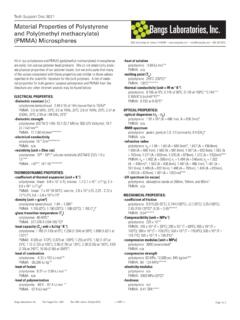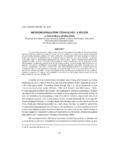Transcription of 10269.01 MS AS Biology AB111 Summer 2016 - CCEA
1 ADVANCED SUBSIDIARY (AS). General Certificate of Education 2016. Biology Assessment Unit AS 1. assessing Molecules and Cells [ AB111 ]. THURSDAY 16 JUNE, AFTERNOON. MARK. SCHEME. F. General Marking Instructions Introduction Mark schemes are published to assist teachers and students in their preparation for examinations. Through the mark schemes teachers and students will be able to see what examiners are looking for in response to questions and exactly where the marks have been awarded. The publishing of the mark schemes may help to show that examiners are not concerned about finding out what a student does not know but rather with rewarding students for what they do know. The Purpose of Mark Schemes Examination papers are set and revised by teams of examiners and revisers appointed by the Council.
2 The teams of examiners and revisers include experienced teachers who are familiar with the level and standards expected of students in schools and colleges. The job of the examiners is to set the questions and the mark schemes; and the job of the revisers is to review the questions and mark schemes commenting on a large range of issues about which they must be satisfied before the question papers and mark schemes are finalised. The questions and the mark schemes are developed in association with each other so that the issues of differentiation and positive achievement can be addressed right from the start. Mark schemes, therefore, are regarded as part of an integral process which begins with the setting of questions and ends with the marking of the examination.
3 The main purpose of the mark scheme is to provide a uniform basis for the marking process so that all the markers are following exactly the same instructions and making the same judgements in so far as this is possible. Before marking begins a standardising meeting is held where all the markers are briefed using the mark scheme and samples of the students' work in the form of scripts. Consideration is also given at this stage to any comments on the operational papers received from teachers and their organisations. During this meeting, and up to and including the end of the marking, there is provision for amendments to be made to the mark scheme. What is published represents this final form of the mark scheme.
4 It is important to recognise that in some cases there may well be other correct responses which are equally acceptable to those published: the mark scheme can only cover those responses which emerged in the examination. There may also be instances where certain judgements may have to be left to the experience of the examiner, for example, where there is no absolute correct response all teachers will be familiar with making such judgements. F 2. / denotes alternative points AVAILABLE. ; denotes separate points MARKS. comments on mark values are given in bold comments on marking points are given in italics Section A. 1 Labels as follows: G;. B;. D;. E;. F; [5] 5. 2 (a) (i) A condensation.
5 B hydrolysis; [2]. (ii) Peptide bond; [1]. (iii) Dipeptide; [1]. (b) Bonding properties/solubility/polarity/identity/ pH/formation of secondary, tertiary or quarternary structure; [1] 5. 3 (a) Accurate drawing of whole section;. showing relationship between tissue layers;. Quality of diagram/no broken lines/no cells;. Any three from the following structures/layers: upper epidermis/lower epidermis palisade mesophyll spongy mesophyll vascular tissue/phloem/sieve tubes/xylem [6]. (b) 50 mm;. 50 3 1000 5 50 000 m;. 50 000/500 5 100; [3]. (c) (i) Maximise light absorption/less chance of light passing through leaf without striking a chloroplast/more chlorophyll for light absorption; [1].
6 (ii) Some cells lost/torn due to preparation; [1] 11. F 3. 4 (a) (i) Conjugated proteins; AVAILABLE. structure consists of a polypeptide combined with a non-protein group/ MARKS. sugar/carbohydrate residue; [2]. (ii) Regulates fluidity/stability of the cell membrane/provides support; [1]. (b) (i) Endocytosis/phagocytosis; [1]. (ii) There is negative correlation between level of NPC1 protein and survival/as the level of NPC1 protein increases survival decreases;. NPC1 protein allows the genetic material to enter cytoplasm/leave the vesicle;. once in the cytoplasm virus can be replicated/can go on to infect other cells; [3] 7. 5 (a) (i) Cytokinesis; [1]. (ii) Any two from: cell increases in size/volume/mass protein synthesis/RNA/enzymes synthesis organelles replicate/are synthesised [2].
7 (iii) Centrioles involved in animal cells (or converse);. Cleavage furrow (by description) in animal cells/formation of cell plate (by description) in plant cells; [2]. (b) 3 37;. 3 720 = 58 minutes; [2] 7. 6 (a) A Cellulose B Glycogen C Starch/amylose/amylopectin D Sucrose E Deoxyribose [5]. (b) Glycogen is hydrolysed rapidly/provides rapid energy source;. animals move so therefore cannot be too massive/heavy/movement is not restricted by mass/same amount of energy is stored in a smaller mass; [2]. (c) Appropriate safety precaution explained;. Any four from: add dilute (1M) hydrochloric acid to sample heat in a water bath neutralise with dilute sodium hydrogencarbonate/sodium hydroxide add Benedict's reagent and heat again in a water bath (green/yellow)/brick red precipitate indicates presence of reducing sugar [5] 12.
8 F 4. 7 (a) (i) 0 kPa; AVAILABLE. they are equal/ cell = s; [2] MARKS. (ii) = 1900 400;. 2300 kPa; [2]. (b) (i) Similar size with cuticle present;. shape straight/backwards curvature; [2]. (ii) Water potential of the bathing solution is higher relative to the tissue;. water moves from higher to lower water potential/from the solution to the tissue;. causes cell expansion/swelling/turgidity and differential lengthening of inner compared to outer layers/resulting in inner layer becoming longer than outer layer; [3]. (c) Water enters the cells by osmosis making the cells swell and lysis occurs;. so haemoglobin is released making solution pale red/due to absence of cell wall; [2]. (d) Contractile vacuoles remove water (that enters by osmosis).
9 So preventing lysis; [2] 13. Section A 60. F 5. Section B AVAILABLE. MARKS. 8 (a) Increasing enzyme concentration increases rate of reaction to a particular point and then further increase in enzyme concentration has no further effect on rate of reaction/rate remains unchanged (not reaction stops);. increase in enzyme concentration provides more active sites;. allowing more enzyme-substrate complexes to form;. at higher enzyme concentrations the number of substrate molecules will become limiting (as enzyme-substrate complexes form at maximal rate); [4]. (b) Any nine from: (maximum four marks name and description). adsorption attaches enzyme to the surface of an inert material (such as glass or a matrix by weak forces).
10 Entrapment traps the enzyme within/between strands of a polymer (such as alginate beads or microspheres ). encapsulation (enmeshment). traps the enzymes within a partial/selectively permeable membrane (such as nylon). cross-linkage covalently bonds enzymes to a matrix (such as cellulose). Advantages (maximum five marks from advantages/disadvantages). increased thermal/pH stability/thermostability can be recovered and reused easily allows for continuous/column reactors with faster production downstream processing of product is simplified and purification costs are reduced/reduces possibility of allergic response in consumer/. product is enzyme-free Disadvantages when enzymes are immobilised the matrix or gels used for immobilisation may reduce speed of diffusion of substrate/enzyme may be wasted off/build-up of byproduct within the matrix enzyme active site may be in wrong orientation/partially blocked reactions used in the immobilisation process may result in shape change of the active site initial set-up/research costs high [9].














